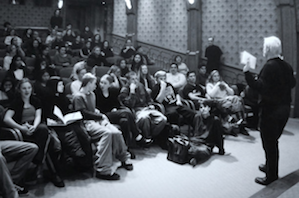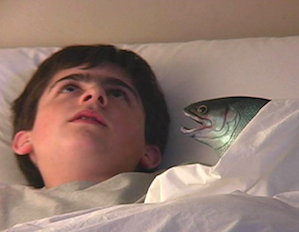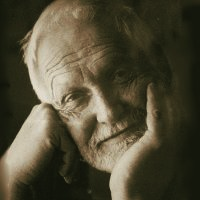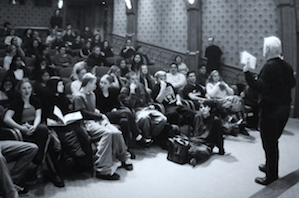
It’s always interesting to catch a man in a rant, or a “vent” as Ronald Chase put it the other day. He was in no mood, and if this sounds like an old anthem, for him it is always new and unsettling.
Chase is the 79-year-old artist-photographer-filmmaker-opera stage designer-educator-and good-natured Sisyphus who 20 years ago created the San Francisco Art & Film Program for teenagers.
The program was conceived as a way to ensure the next generation would come to love the arts and perhaps one day take responsibility for their survival. The idea was to bring children, rich and poor alike, to the symphony, the opera, the theater, dance, films, and art galleries — all in the spirit of Leonard Bernstein’s Young People’s Concerts in the late 1950s.
The free program, which by its scope is unique in the country, is open to any student in the Bay Area, from late middle school through college. Chase solicits tickets from all the local arts organizations and offers 120 cultural events a year, including music, dance, theater, galleries, and film. He takes kids to arts galleries two Saturdays s a month and to the symphony two or three times a month. He has film screenings every Friday night at the Randall Museum in San Francisco. He also offers a filmmaking class each Sunday. The class costs $1,500, although scholarships are available.
Incidentally, on Thursday, Oct. 24, the Roxie Theater is paying a 20th anniversary tribute to sf Art & Film with a film festival of student-made films (by filmmakers ages 13 to 20). To sign up for the mailing list, use this form.
And Now, to the Vent!
And so why Mr. Chase’s hullaballoo?

S.F. International, Best Student Film - American Academy of Television
“There’s a dark storm gathering in this country,” he said ominously, referring to a never-ending lack of appreciation and exposure to the arts among young people. It’s a problem among parents and teachers who themselves have lost touch with the arts, says Chase, and a problem among local funders who too often don’t see the value — which is an interesting commentary on San Francisco, the city that imagines itself as the Oz of the arts.
To be sure, Ronald Chase’s effort has been a great success. The kids who have taken the program swear by it. The parents who have seen the effects on their children are jumping out of their seats. Moreover, when Chase started out in 1993, he had 18 kids; now nearly 500 attend some events each month. Of that, a core group of 75 attend regularly. Indeed, Chase has done so well that sometimes coordination is a problem. He has a small volunteer staff to help him.
Last year, 140 schools were represented in the program, with the largest contingents coming from Lowell High School, the Ruth Asawa School of the Performing Arts, Lincoln High School, The International School, and Lick Wilmerding.
Referring to one private school in the city, and an arts-oriented school at that, Chase noted, “Yes, I think we got four students to come, but the fact is the whole school should be coming.”
It’s Ronald’s cross to bear that he can’t get more kids more to attend regularly, which, he says, is a function of a new culture that holds the arts at arm’s length.
“Ten years ago, we had no trouble finding kids to do these things, but here’s something that will astound you: I often meet music teachers who haven’t been to the symphony in years. I meet art teachers who haven’t been downtown to a gallery, or a museum, in years. Of course these people are too taxed, they’re overwhelmed, but the truth is also that their curiosity just isn’t there. And so perhaps it’s no wonder there’s an abysmal lack of curiosity among young people today.”
No Easy Road

And there are other obstacles, according to Chase: the fact that some kids, through poverty or some other circumstance, are just cut off from this kind of program; it’s a bridge too far. There’s also a lack of mentors to give ‘coolness’ and credibility to the arts, and a disinterest among artists themselves, who are caught up in their own struggles and don’t have time to play a more assertive role.
Still another obstacle is the perception that the program is elitist. Once a year, one of the board members of sf Art & Film gives a sit down dinner for about 30 kids, complete with a string quartet. “Nobody famliar with this kind of thing would think twice,” says Chase, “but others get worried about the very idea of such a dinner — ‘this is elitist. We’re not going to support that.’”
And then there’s the feeling among many parents, particularly in San Francisco, that you just can’t order kids to do anything. “What I’ve found,” says Chase, “ is that parents don’t want to say anything to their children about going to the symphony, for example, because they’re afraid their children will hate it, and maybe also hate them!”
Finally, there’s the matter of financial support, which has been intermittent in San Francisco and almost null in Silicon Valley. Interestingly, and embarrassingly perhaps, sf Art & Film for Teenagers, got its initial funding in New York, through the Jacob Merrill Kaplan Foundation. Kaplan still provides support along with money from the NEA, which began support in 2004.
“Yes, our first benefit was in New York,” says Chase. “ It took years to find support in San Francisco.” And why was that?
“I often meet music teachers who haven’t been to the symphony in years.” -sf Art & Film founder Ronald Chase
“Because I think people in New York understood this crisis before a lot of other people. They understood what it would mean if the next generation was not drawn into the arts culture.”
“You know, you so often you feel you’re facing a huge wall of indifference.”
Empowerment, Old-School Style
One of my most cherished memories from growing up in New York City was going to Leonard Bernstein’s Young People’s Concerts. On Saturday mornings you got on a bus, in your coat and tie, which was not dress-up because you wore that to school anyway, and got off at 57th Street, walking past the Russian Tea Room to Carnegie Hall, where all your friends were gathering, along with the music teachers. To attend any cultural event, whether a concert or play or a trip to a museum was so part of a routine, so much the ‘norm,’ that you’d never think to question it. Indeed, it was an empowerment and very conscious empowerment at that.
Of course, there were occasional prohibitions but no intermediate ‘kid culture’ for books, films, or music. You stepped right into the world of adults, and if you couldn’t comprehend a performance or a painting, familiarity eventually got you through. Which became a life lesson in itself: If something is difficult, spend time with it, look at it again and again, and eventually it will reveal itself.
“Every now and then I mention the word, ‘beauty’. It has gone out of our vocabulary.” -Ronald Chase
The lament, and Mr. Chase’s true vent, is that getting kids to any artistic event has become the making of a miracle. The arts are no longer in the routine, and access to the arts has become something discussable, a negotiation, a choice. A luxury. The result is not only a sense that the arts are unreachable and ‘difficult’, but that the beauty they encompass is somehow unknowable.
“Every now and then I mention the word, ‘beauty,’” he told me. “It has gone out of our vocabulary. I ask kids, even in our film workshop: When’s the last time you heard the word ‘beauty’? Some have not heard it in a year. Some, not in two months. Some hadn’t heard it at all; they just don’t use the word. It doesn’t enter the modern sensibility. Of course, people in the arts may use the word but out in society it tends to be used only in the context of sunsets. But what beauty is is never discussed. What’s good is discussed or what ‘works’ is discussed … and so some of us have joined together with this humble idea of bringing that word and that feeling back into young people’s lives, so they can find out what it means to have a beautiful experience, or what it means to be excited and inspired by the arts.”
He added, “you know, I’ve found this is so true: If you’re sitting in the second row and you hear a Mahler symphony and you’ve never been to the symphony before, there is no way that you’re going to dismiss that experience. We’ve seen that again and again. If you can get kids into the seat you have a good chance of keeping them there.”

